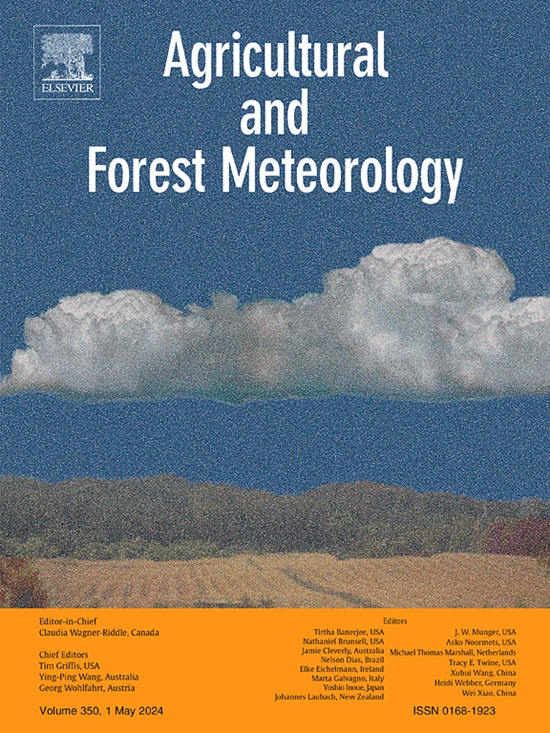基于物理引导的作物物候模拟深度学习的连续学习框架
IF 5.6
1区 农林科学
Q1 AGRONOMY
引用次数: 0
摘要
基于过程的模型(PBMs)和人工智能模型(AIMs)都被广泛用于模拟各种环境条件和农场管理实践下的作物生长。由于其机制基础,pbm提供了可解释模拟的优势,但作物生长机制研究的最新见解往往不能及时纳入pbm。此外,虽然AIMs可以直接从数据中提取潜在的模式,但由于缺乏对作物生长过程的考虑,它们难以生成时间连续的模拟,从而限制了其模拟的可解释性。为了将PBMs和AIMs的优势协同起来,我们开发了一个持续学习框架AGLPF (APSIM引导LSTM物候学框架)来动态模拟中国玉米带玉米物候学的变化。AGLPF由PBM (APSIM)、物候数据集和基于注意-长短期记忆(LSTM)的AIM组成。当最初使用PBM输出数据集在AGLPF中训练AIM时,AGLPF能够复制PBM结果,营养生长期和开花期的平均RMSE为0.8天,灌浆期为1.4天,整个生长周期为2.0天。随着从0年到12年的实际物候数据被用于自调优训练,AGLPF的模拟越来越符合实际数据。值得注意的是,整个生长周期的RMSE从27.8 d稳步下降到5.5 d。此外,自调整训练方法在所有物候阶段的模拟中都优于从头开始训练方法。AGLPF的开发提供了一个框架,可以考虑物理指导的AIM来模拟作物物候甚至其他与作物相关的变量,同时易于升级和易于解释输出。本文章由计算机程序翻译,如有差异,请以英文原文为准。
A continuous learning framework based on physics-guided deep learning for crop phenology simulation
Process-based models (PBMs) and artificial intelligence models (AIMs) are both widely used to simulate crop growth under various environmental conditions and farm management practices. PBMs offer the advantage of interpretable simulations due to their mechanistic underpinnings, but the latest insights from crop growth mechanism research are often not promptly incorporated into PBMs. Further, while AIMs can directly extract potential patterns from data, they struggle to generate temporally continuous simulations due to their lack of consideration for crop growth processes, thus limiting the interpretability of their simulations. To synergize the strengths of PBMs and AIMs, we developed a continuous learning framework, AGLPF (APSIM Guided LSTM Phenology Framework), to dynamically simulate the changes in maize phenology across the Chinese Maize Belt. The AGLPF consists of a PBM (APSIM), its phenology dataset, and an AIM based on attention-Long short-term memory (LSTM). When initially training the AIM in AGLPF by the PBM output dataset, the AGLPF was capable of replicating the PBM outcomes, with an average RMSE of 0.8 days for the vegetative growth phase and flowering phase, 1.4 days for the grain filling phase and 2.0 days for the full growing cycle. With incremental actual phenology data from 0 to 12 years being used for self-tuning training, the simulations of the AGLPF increasingly aligned with actual data. Notably, the RMSE of the full growing cycle steadily declined from 27.8 days to 5.5 days. Moreover, the self-tuning training method performed better than the from-scratch training method in the simulation of all the phenological phases. The development of AGLPF has provided a framework to consider physics-guided AIM to simulate crop phenology and even other crop-related variables while being easy to upgrade and easily interpret outputs.
求助全文
通过发布文献求助,成功后即可免费获取论文全文。
去求助
来源期刊
CiteScore
10.30
自引率
9.70%
发文量
415
审稿时长
69 days
期刊介绍:
Agricultural and Forest Meteorology is an international journal for the publication of original articles and reviews on the inter-relationship between meteorology, agriculture, forestry, and natural ecosystems. Emphasis is on basic and applied scientific research relevant to practical problems in the field of plant and soil sciences, ecology and biogeochemistry as affected by weather as well as climate variability and change. Theoretical models should be tested against experimental data. Articles must appeal to an international audience. Special issues devoted to single topics are also published.
Typical topics include canopy micrometeorology (e.g. canopy radiation transfer, turbulence near the ground, evapotranspiration, energy balance, fluxes of trace gases), micrometeorological instrumentation (e.g., sensors for trace gases, flux measurement instruments, radiation measurement techniques), aerobiology (e.g. the dispersion of pollen, spores, insects and pesticides), biometeorology (e.g. the effect of weather and climate on plant distribution, crop yield, water-use efficiency, and plant phenology), forest-fire/weather interactions, and feedbacks from vegetation to weather and the climate system.

 求助内容:
求助内容: 应助结果提醒方式:
应助结果提醒方式:


